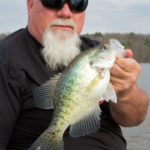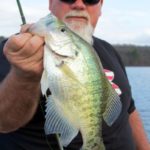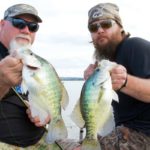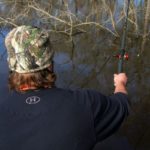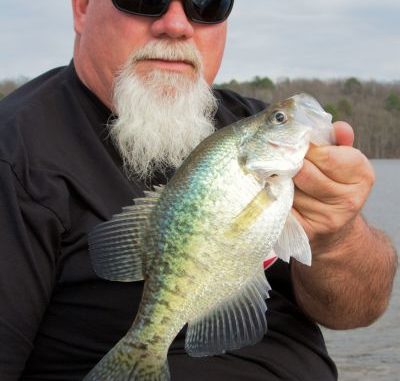
Staying where you aren’t catching fish seems dumb, but we all do it figuring the fishing will turn on. These crappie fanatics load up their boat and head to more-productive waters — and always come home with fish.
Moving is a hassle.
Whether it’s cushioning the china in newspaper, bearing the weight of heavy boxes or figuring out what to do with the furniture, nobody likes to move.
But the eternal optimism of better opportunity in other places pulls us through.
This hope for a better life is what made pilgrims sail to Plymouth Rock.
It is what made pioneers point their wagons westward.
It is what made Neil Armstrong take one small step on the moon.
None of these folks allowed the hassle of moving keep them from moving.
As decoy technician for the Duck Commander crew, John Godwin knows the hassle of moving: It is his responsibility to put out the decoys, position them correctly and pick them up again.
He might not like the hassle of packing up and moving when Phil Robertson calls for a what he calls “a company move,” but Godwin has seen first hand the opportunity on the other side of the cypress trees.
That’s why Godwin and his Duck Commander blind mate Jay Stone didn’t even bat an eye when the white perch weren’t biting at Bayou De Loutre off the Ouachita River just to the southwest of Sterlington.
Both are avid white perch fishermen, but they had never fished Bayou De Loutre before.
They started there on a whim because of a hot fishing report from David Owes from West Monroe’s The Honey Hole tackle shop.
The report was right, but as many fishing reports go, it would have probably gotten even better if Godwin and Stone would have heard it a day or two later.
“The next day there would have been two boats catching 70 fish apiece and one of them would have sunk on the way back to the ramp,” Godwin chuckled, as he and Stone started pulling in their lines.
It wasn’t that Bayou De Loutre was a gar hole — both anglers saw potential in the place — but one small fish maybe every 30 minutes wasn’t enough to make them want to see more.
“When we’re duck hunting in a place where the ducks just won’t quite commit to and we see them landing just a little farther over, it’s time to pick up and move,” Godwin pointed out. “Sometimes you’ve just got to take it to them because it’s the difference in a limit or scrapping out.”
“If you’re not on the X, you’re not going to kill them because the ducks aren’t there,” Stone put in. “Same thing with these white perch. If you’re not where the fish are biting, why in the world would you want to stay?”
Stone identified it as a fisherman’s intuition, and told a story about how he and a friend of his drove from West Monroe to the Boeuf River because they had heard the bite was on.
They fished for three hours before finally deciding to load up and drive all the way back to Holland’s Bluff landing on Bayou D’Arbonne, where they proceeded to catch 50 white perch.
With just a few dinks in the livewell of Godwin’s “crappie cadillac,” the pair discussed the good things they just knew were waiting on them at the end of their 25-minute drive.
“Sometimes you just got to put it on the trailer and make a road trip if you want to catch them,” Godwin noted, as he relaunched his boat at the Lake D’arbonne spillway ramp on the Farmerville side.
“It’s hard to make a move when you’re marking as many fish as we were at De Loutre and catching one every once in a while because you know they could turn on in 30 minutes.”
With the company move in their rearview mirror, Godwin and Stone began spider-rigging tube jigs tipped with minnows over the edges of the unmarked channel close to the D’Arbonne spillway.
The spot only gave up two small fish, so the two packed up again. Only this time it was more of a bass fishing move than a full-scale company move.
“Only we’ve got 16 poles to pack up rather than one or two,” Stone quipped, as he and Godwin pulled in lines yet again to head up the lake to try some other spots.
Several boats were congregated around the Highway 33 bridge, a well-known community hole, and Godwin couldn’t help but come off plane and give it a try.
“This bridge can be really good because, when the lake is up, a lot of brush hangs up on the pilings,” Godwin explained. “And there are a couple man-made brush piles close by. Throw in all these boats fishing, and that gives the indication that they might be biting.”
They weren’t.
After loading up everything yet again, Godwin and Stone headed up to Fork’s Ferry where Little D’Arbonne and Corney Creek merge into D’Arbonne Bayou. The sight of one angler sliding a slab white perch into his cooler gave a glimmer of hope that their moving might have finally come to an end.
Stone grabbed a giant chain that was tied onto a rope and slid it out the back of Godwin’s boat while Godwin set out eight poles at the front.
Before Stone could even get to the front to take his seat beside Godwin, his No. 2 pole bowed deeply into the water. His reaction wasn’t fast enough, but his intuition began to kick in.
“We’re about to get on them,” he announced. “I got a good feeling about this spot.”
Within the next hour or so, everything Godwin and Stone had been trying to teach me about how to spider rig for white perch suddenly came to life.
They worked the edge of the channel where it dropped off from 12 feet down to 30 feet. White perch ganged up on the lip must have thought a giant school of blue and chartreuse shiners looked too appetizing to pass up.
And when Godwin and Stone got a little bit too close to a set of three stumps right on the edge of the channel, more poles bent than they had hands to grab.
Later that evening at the fish fry, we dined on 42 fresh white-perch fillets.
Twenty-one fish might not sound like much for a couple of white perch anglers accustomed to loading the boat, but it was 21 more fish than would have been eating had they not decided to make the company move from the Ouachita River to Lake D’Arbonne.
“I don’t know how many people would actually decide to make a move like this over just making up their minds to go home,” Godwin wondered. “But we’re so used to making company moves that we don’t think twice about putting the boat on the trailer if we’re not catching any fish and go to where we think we might catch some.”
“Once you realize all hope is lost,” Stone finished, “it’s time to call the dogs and pee on the fire, and find some place where the fish are biting.”
Sure, it’s a hassle, but the eternal optimism that the fish are biting better at some other lake can only be realized if you are willing to make a company move.
